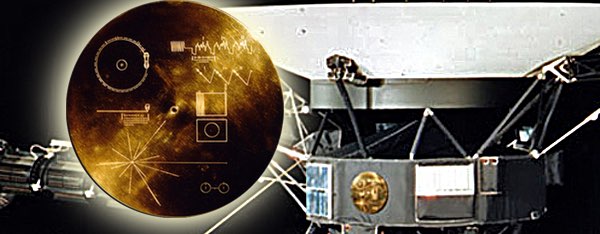- By Linda Glaser
- Around Town
 Print
Print  Photos by NASA/JPL
Photos by NASA/JPLOnly one human-touched object has ever entered interstellar space: NASA's Voyager 1, bearing with it greetings to extraterrestrials in the form of a Golden Record. A special exhibit at Cornell University Library's Division of Rare and Manuscript Collections will feature one of the handful of Golden Record covers that remain on Earth, courtesy of Ann Druyan, never before on public display.
The exhibit is part of the "40 Years of Cosmic Discovery: Celebrating the Voyager Missions and Humanity's Message to Space" at Cornell, which features a panel of luminaries on Oct. 19 at 8 pm in Cornell's Bailey Hall, introduced by Cornell Provost Michael Kotlikoff and featuring people who worked on the mission:
- Ann Druyan, Emmy- and Peabody-award winning writer/producer/director and creative director of NASA's Voyager Interstellar Message;
- Frank Drake, chairman emeritus, SETI Institute and creator of the Drake Equation;
- Steve Squyres, Cornell's James A. Weeks Professor and principal investigator of the Mars Exploration Rovers mission; as well as
- Lisa Kaltenegger, associate professor of astronomy and director of Cornell's Carl Sagan Institute; and
- Jonathan Lunine, the David C. Duncan Professor in the Physical Sciences and director of the Cornell Center for Astrophysics and Planetary Science.
The multi-media library exhibit will include images and sounds from the Golden Record, as well as the original book by Isaac Newton that was photographed for the Golden Record and a first-edition, signed copy of Carl Sagan's "Murmurs of Earth." A copy of the Voyager Golden Record boxed set, newly issued by Ozma Records and donated by producers Timothy Daly and David Pescovitz, will also be on display.
The free exhibit will be open on Thursday, Oct. 19 from 9 am – 5 pm, Friday, Oct. 20 from 9 am – 5 pm, and Saturday, Oct. 21 from 11 am – 5 pm, on level 2B, Kroch Library. The exhibit is part of Cornell University's celebration of the 40th anniversary of Voyagers 1 and 2 and Cornell's central role in the missions and the Golden Record. All events are free, and the public is invited.
The pioneering NASA Voyagers 1 and 2 were launched in 1977 from Cape Canaveral to explore the solar system. They are the only spacecraft to have visited Uranus and Neptune. The gravitational assist from Jupiter that slingshot the Voyagers on the first reconnaissance of the outer solar system will propel them throughout the Milky Way for the next several billion years. Each Voyager bears a complex message affixed to its side in the form of the Golden Record, a 12-inch gold-covered copper record containing greetings, images of life on Earth, world music and other sounds of this planet. They have a shelf life of 1 billion to 5 billion years.
v13i40



